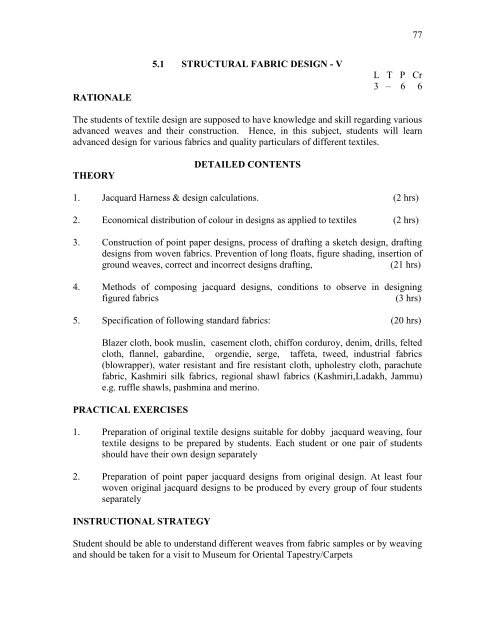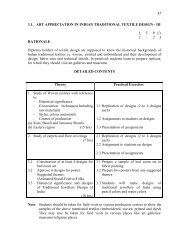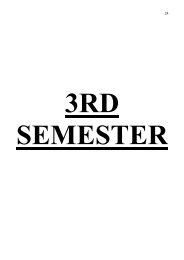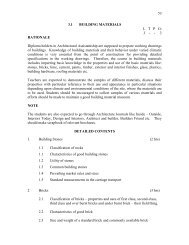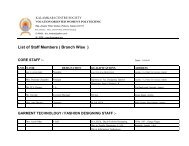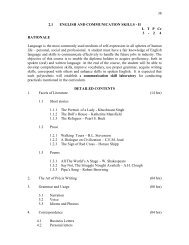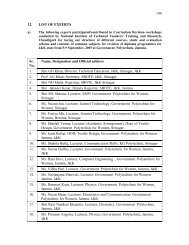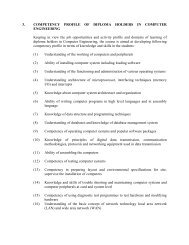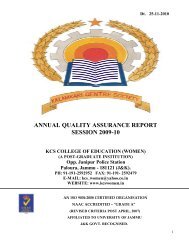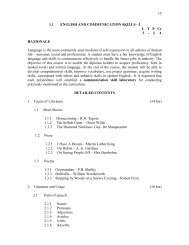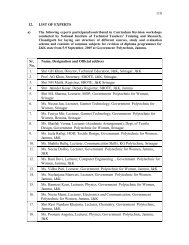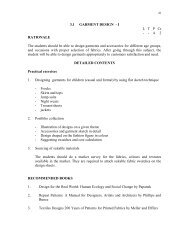6 6 RATIONALE The students of textile design are supposed
6 6 RATIONALE The students of textile design are supposed
6 6 RATIONALE The students of textile design are supposed
Create successful ePaper yourself
Turn your PDF publications into a flip-book with our unique Google optimized e-Paper software.
77<br />
<strong>RATIONALE</strong><br />
5.1 STRUCTURAL FABRIC DESIGN - V<br />
L T P Cr<br />
3 – 6 6<br />
<strong>The</strong> <strong>students</strong> <strong>of</strong> <strong>textile</strong> <strong>design</strong> <strong>are</strong> <strong>supposed</strong> to have knowledge and skill regarding various<br />
advanced weaves and their construction. Hence, in this subject, <strong>students</strong> will learn<br />
advanced <strong>design</strong> for various fabrics and quality particulars <strong>of</strong> different <strong>textile</strong>s.<br />
THEORY<br />
DETAILED CONTENTS<br />
1. Jacquard Harness & <strong>design</strong> calculations. (2 hrs)<br />
2. Economical distribution <strong>of</strong> colour in <strong>design</strong>s as applied to <strong>textile</strong>s (2 hrs)<br />
3. Construction <strong>of</strong> point paper <strong>design</strong>s, process <strong>of</strong> drafting a sketch <strong>design</strong>, drafting<br />
<strong>design</strong>s from woven fabrics. Prevention <strong>of</strong> long floats, figure shading, insertion <strong>of</strong><br />
ground weaves, correct and incorrect <strong>design</strong>s drafting,<br />
(21 hrs)<br />
4. Methods <strong>of</strong> composing jacquard <strong>design</strong>s, conditions to observe in <strong>design</strong>ing<br />
figured fabrics<br />
(3 hrs)<br />
5. Specification <strong>of</strong> following standard fabrics: (20 hrs)<br />
Blazer cloth, book muslin, casement cloth, chiffon corduroy, denim, drills, felted<br />
cloth, flannel, gabardine, orgendie, serge, taffeta, tweed, industrial fabrics<br />
(blowrapper), water resistant and fire resistant cloth, upholestry cloth, parachute<br />
fabric, Kashmiri silk fabrics, regional shawl fabrics (Kashmiri,Ladakh, Jammu)<br />
e.g. ruffle shawls, pashmina and merino.<br />
PRACTICAL EXERCISES<br />
1. Preparation <strong>of</strong> original <strong>textile</strong> <strong>design</strong>s suitable for dobby jacquard weaving, four<br />
<strong>textile</strong> <strong>design</strong>s to be prep<strong>are</strong>d by <strong>students</strong>. Each student or one pair <strong>of</strong> <strong>students</strong><br />
should have their own <strong>design</strong> separately<br />
2. Preparation <strong>of</strong> point paper jacquard <strong>design</strong>s from original <strong>design</strong>. At least four<br />
woven original jacquard <strong>design</strong>s to be produced by every group <strong>of</strong> four <strong>students</strong><br />
separately<br />
INSTRUCTIONAL STRATEGY<br />
Student should be able to understand different weaves from fabric samples or by weaving<br />
and should be taken for a visit to Museum for Oriental Tapestry/Carpets
78<br />
RECOMMENDED BOOKS<br />
1. Watson’s Advance Textile Design<br />
2. Watson’s Textile Colour and Design<br />
3. Grammer <strong>of</strong> Textile Design by Nisbet<br />
4. Structural Fabric Design by Kilby<br />
5. Woven Structures and Design I and II by Davis Goerner<br />
6. Impressions – Master Pieces <strong>of</strong> Indian Textiles by K Prakash<br />
7. Shawls and Carpets <strong>of</strong> Kashmir by All India Handicraft Board, New Delhi<br />
8. Simple Fabric Structure by S S Satsangi<br />
SUGGESTED DISTRIBUTION OF MARKS<br />
Topic No. Time Allotted (Hrs) Marks Allotted (%)<br />
1 2 4<br />
2 2 4<br />
3 21 44<br />
4 3 6<br />
5 20 42<br />
Total 48 100
79<br />
5.2 FUNDAMENTALS OF KNITTING<br />
L T P Cr<br />
3 - 4 5<br />
<strong>RATIONALE</strong><br />
<strong>The</strong> aim <strong>of</strong> this subject is to impart knowledge and skills to the <strong>students</strong> regarding various<br />
types <strong>of</strong> knits and their use in the <strong>textile</strong> <strong>design</strong> as they may have to work in knitting<br />
industry and import and export houses as well.<br />
DETAILED CONTENTS<br />
Sr.<br />
<strong>The</strong>ory<br />
No.<br />
1. Comparison between knitted and woven<br />
fabrics, warp and weft knitting. Types <strong>of</strong><br />
knitting needles, their knitting cycle<br />
(18 hrs.)<br />
2. Weft Knitting<br />
Types <strong>of</strong> stitches: Knit, tuck, float, lay their<br />
representation, effects<br />
( 6 hrs.)<br />
3. Weft knit structures: Plain, Rib, Interlock<br />
and Purl, their characteristics<br />
(12 hrs.)<br />
Practical Exercises<br />
- Demonstration <strong>of</strong> different<br />
needles and their cycles<br />
- Yarn parameters for hosiery<br />
yarn<br />
Preparation <strong>of</strong> knit tuck and float<br />
stitches.<br />
Passage <strong>of</strong> yarn through Flat Bed<br />
and Circular Weft Knitting<br />
Machines<br />
4. Fabric defect in weft knitting (4hrs.) - Identification <strong>of</strong> fabric defects<br />
on the knitted fabrics<br />
5. Warp Knitting: Introduction to under lap<br />
and over lap, closed lap and open lap.<br />
Elementary idea <strong>of</strong> Tricot and Raschel<br />
machines<br />
(8 hrs)<br />
- Study <strong>of</strong> warp knitted samples<br />
with respect to the topics<br />
INSTRUCTIONAL STRATEGY<br />
Student may be asked to do the work on weft knitting machines and construct the lapping<br />
movement <strong>of</strong> warp knits.<br />
RECOMMENDED BOOKS<br />
1. Knitting technologies by D.B. Ajgaokar<br />
2. Knitting technology by Mark Spancer<br />
3. Textile Mathematics Vol III by J.E. Booth
80<br />
SUGGESTED DISTRIBUTION OF MARKS<br />
Topic No. Time Allotted (Hrs) Marks Allotted (%)<br />
1 18 38<br />
2 6 12<br />
3 12 26<br />
4 4 8<br />
5 8 16<br />
Total 48 100
81<br />
5.3 COMPUTER AIDED TEXTILE DESIGN - II<br />
<strong>RATIONALE</strong><br />
L T P Cr<br />
- - 6 3<br />
<strong>The</strong> term CAD has found its way into all major discipline that have got anything to do<br />
with <strong>design</strong>ing or drafting techniques. <strong>The</strong> major objective <strong>of</strong> this course is to expose the<br />
<strong>students</strong> to different s<strong>of</strong>tw<strong>are</strong>s available in the field <strong>of</strong> <strong>textile</strong> <strong>design</strong> industry so that they<br />
<strong>are</strong> able to use those s<strong>of</strong>tw<strong>are</strong>s in the <strong>design</strong> and construction <strong>of</strong> various <strong>textile</strong>s.<br />
Related <strong>The</strong>ory for Practical Exercises<br />
DETAILED CONTENTS<br />
1. Philosophy and utility <strong>of</strong> CATD system, working with various standard s<strong>of</strong>tw<strong>are</strong><br />
packages like photoshop, coral draw, NedGraphics, Auto Tex (for <strong>textile</strong> <strong>design</strong>)<br />
Nanos<strong>of</strong>t, Textronics<br />
2. Understanding graphic representation, file conversion, drawing simple geometric<br />
figures, capturing a single colour picture <strong>design</strong> using CCD/Scanner<br />
3. Use <strong>of</strong> computer to construct <strong>design</strong> on different bases with reference to various<br />
arrangements for woven <strong>design</strong>s<br />
4. Use <strong>of</strong> CATD in various end uses in single colour viz a viz dress material,<br />
upholstry, furnishing, label, & embroidery with the help <strong>of</strong> NedGraphics, Auto<br />
Tex (for Textile Design), Textronics<br />
PRACTICAL EXERCISES<br />
1. To draw 3 geometrical folk <strong>design</strong>s with Coraldraw<br />
2. To do colour ways <strong>of</strong> the Ex.1 using Coraldraw<br />
3. Create different textures for background and <strong>design</strong> using booties/natural objects<br />
which the student will create using digitiser<br />
4. Make 3 woven <strong>design</strong> for shirting material using different strips, checks, dals<br />
5. Do colour ways <strong>of</strong> Ex.4<br />
6. Scan a 10 inch x15 inch <strong>design</strong> and learn to stitch making a single image<br />
7. Design a logo for your production unit with written words also
82<br />
RECOMMENDED BOOKS<br />
1. CAD in clothing and <strong>textile</strong>s by W.Aldrich<br />
2. A magazine on Computer in the world <strong>of</strong> <strong>textile</strong>s<br />
3. NedGraphics<br />
4. Coral draw and Adobe Photoshop<br />
5. Wacom Digitiser
83<br />
5.4 TEXTILE TESTING AND QUALITY CONTROL - I<br />
<strong>RATIONALE</strong><br />
L T P Cr<br />
4 - 4 6<br />
Diploma holders in <strong>textile</strong> <strong>design</strong> <strong>are</strong> responsible for testing and quality control <strong>of</strong> yarn<br />
and fabric at the shop floor. Thus in this subject, student will be made fully aw<strong>are</strong> <strong>of</strong><br />
different quality standards and their maintenance during manufacturing processes for the<br />
total quality concept<br />
DETAILED CONTENTS<br />
Sr.<br />
<strong>The</strong>ory<br />
No.<br />
1. Textile testing - its aim & scope. Concept <strong>of</strong><br />
quality control and its importance. Methods <strong>of</strong><br />
quality control. Concept <strong>of</strong> ISO<br />
(8 hrs)<br />
Practical Exercises<br />
2. Importance <strong>of</strong> fixing standards. Brief idea <strong>of</strong><br />
factors responsible for deviation from standards.<br />
(6 hrs)<br />
3. Sampling techniques. Random and biased<br />
samples. Techniques for fabric sampling for<br />
specific tests.<br />
(8 hrs)<br />
Methods <strong>of</strong> yarn numbering system (dired<br />
4. Measurement <strong>of</strong> yarn number from large<br />
and small yarn lengths. Beesley’s and<br />
Knowle’s balance.<br />
(10 hrs)<br />
1.<br />
5. Yarn twist and its measurement, direction <strong>of</strong><br />
twists. Function <strong>of</strong> twist in yarn structure.<br />
Effect <strong>of</strong> twist on yarn Properties.<br />
Measurement <strong>of</strong> twist in single and ply yarns.<br />
(10 hrs)<br />
6. Chemical testing:<br />
Test <strong>of</strong> colour fastness for<br />
(a) Washing<br />
(b) Rubbing (Wet & Dry)<br />
(c) Dry cleaning<br />
(d) Perspiration (Alkaline & Acidic medium)<br />
Preparation <strong>of</strong> leas <strong>of</strong> different<br />
sizes on wrap reel<br />
Measurement <strong>of</strong> yarn number<br />
from large and small length<br />
samples - use <strong>of</strong> Knowle’s and<br />
Beesley’s balances<br />
Direct weighing methods and<br />
Analytical balance<br />
Measure <strong>of</strong> twist in single and<br />
folded yarns by twist testers.<br />
Use <strong>of</strong> laundrometer for wash<br />
fastness testing<br />
Crockmeter for testing <strong>of</strong><br />
rubbing fastness<br />
Demonstration <strong>of</strong> Grey scale &<br />
Blue scale.
84<br />
(e) Light<br />
(f) Chlorination.<br />
(10 hrs)<br />
7. Fibre Identification ( 2 hrs) - Microscopic test<br />
- Burning test<br />
- Solubility test<br />
8. Weight per sq. meters or per sq. yards ( 2 hrs) Quadrant balance<br />
a) For woven fabric<br />
(Temple <strong>are</strong>rectalar)<br />
b) For knitted fabric<br />
(Round cutter)<br />
9. Blend test by (Microscopic, burning and<br />
chemical processes).<br />
(6 hrs)<br />
Blend test by use <strong>of</strong> Microscope<br />
and solubility process.<br />
10. Air permeability test (2 hrs) Use <strong>of</strong> air permeability tester<br />
Note: All testing procedures <strong>are</strong> to be followed as per laid down standards by BIS.<br />
INSTRUCTIONAL STRATEGY<br />
Student must be taken to <strong>textile</strong> industries/Mills for practice and study <strong>of</strong> inspection and<br />
quality control operations<br />
RECOMMENDED BOOKS<br />
1. Textile Testing by JE Booth<br />
2. Textile Testing by Grover and Hambey<br />
3. Textile Testing by Angapan<br />
4. Textile Testing by John H.Skinkle<br />
SUGGESTED DISTRIBUTION OF MARKS<br />
Topic No. Time Allotted (Hrs) Marks Allotted (%)<br />
1 8 12<br />
2 6 10<br />
3 8 12<br />
4 10 18<br />
5 10 18<br />
6 10 18<br />
7 2 2<br />
8 2 2<br />
9 6 10<br />
10 2 2<br />
Total 64 100
85<br />
<strong>RATIONALE</strong><br />
5.5 TEXTILE FINISHING<br />
L T P Cr<br />
3 - - 3<br />
A diploma holder in <strong>textile</strong> <strong>design</strong> must have necessity knowledge and procedures used<br />
for finishing. For this, he should be acquainted with different types <strong>of</strong> processing <strong>of</strong><br />
finishing machines used for finishing. In addition, relevant skills also need to be<br />
developed in him about the operation <strong>of</strong> these machines.<br />
<strong>The</strong>ory<br />
DETAILED CONTENT<br />
1. Introduction, objects <strong>of</strong> finishing and its importance. (2 hrs.)<br />
2. Classification <strong>of</strong> various types <strong>of</strong> finishes (2 hrs.)<br />
3. Study <strong>of</strong> finishes with respect to the purpose, fabrics and reagents used. (2 hrs.)<br />
4. Textural finishes, their types and techniques (2 hrs.)<br />
5. Mechanical finishes and its applications (12 hrs.)<br />
- Sanforizing<br />
- Calendering<br />
- Crabbing and Milling<br />
- Anti-felting<br />
- S<strong>of</strong>tening<br />
- Decatising/blowing<br />
- Paper pressing<br />
6. Chemical Finishes (14 hrs.)<br />
- Water pro<strong>of</strong> and water repellent finishes<br />
- Flame retardant finishes<br />
- Soil release and soil repellent finishes<br />
- Antibacterial & moth pro<strong>of</strong>ing finishes<br />
- Crease/wrinkle resistant finishes<br />
7. Assessment <strong>of</strong> Quality <strong>of</strong> Finished Textiles (6 hrs.)<br />
8. Effluents and its treatments (6 hrs.)<br />
9. Latest developments in finishing<br />
(2 hrs.)
86<br />
INSTRUCTIONAL STRATEGY<br />
<strong>The</strong> <strong>students</strong> should be taken to <strong>textile</strong> industry to show them various processes <strong>of</strong><br />
finishing and its machinery so that they can know the various finishing processes being<br />
used by <strong>textile</strong> industry.<br />
REFERENCE BOOKS<br />
1. Technology <strong>of</strong> Finishing, Vol. 10 by VA Shenai and NM Sharaf,, Sevak<br />
Publication, Mumbai<br />
2. Textile Finishing by JT Marsh, BI Publications, New Delhi<br />
3. Effluents by ATIRA<br />
4. Textile Fiber to Fabric by Bernard P. Corbman, McGraw Hill International<br />
Editions<br />
5. Textile Finishing by Hall, AJ, Haywood Books, London<br />
6. Basic Water Treatment by Smethwurst G, IBT Publications, New Delhi<br />
7. Treatment <strong>of</strong> Textile Processing Effluent by Manivasaram N, Sakthi Publications,<br />
Coimbatore<br />
8. Production <strong>of</strong> Synthetic Fibres by Vaidya AA, Prentice Hall India Ltd., New<br />
Delhi<br />
9. Textile Auxiliaries and Finishing Chemicals by AA Vaidya and SS Trivedi,<br />
ATIRA, Ahmedabad<br />
SUGGESTED DISTRIBUTION OF MARKS<br />
Topic No. Time Allotted (Hrs) Marks Allotted (%)<br />
1 2 4<br />
2 2 4<br />
3 2 4<br />
4 2 4<br />
5 12 26<br />
6 14 30<br />
7 6 12<br />
8 6 12<br />
9 2 4<br />
Total 48 100
87<br />
<strong>RATIONALE</strong><br />
5.6 MANAGEMENT AND TEXTILE COSTING<br />
L T P Cr<br />
3 - - 3<br />
Management and costing assumes vital importance for a diploma holder in <strong>textile</strong> <strong>design</strong>.<br />
He must appreciate the value <strong>of</strong> leadership, motivation, human relations etc. because he is<br />
to work in team in a <strong>textile</strong> industry. Creating aw<strong>are</strong>ness regarding industrial legislation,<br />
environmental education and entrepreneurship will help the <strong>students</strong> to perform their jobs<br />
more effectively.<br />
THEORY<br />
DETAILED CONTENTS<br />
1. Introduction to Management, different functions <strong>of</strong> management: planning,<br />
organizing, coordination and control<br />
( 3 hrs)<br />
2. Management Structure <strong>of</strong> an industrial organization with relation to <strong>textile</strong><br />
industry<br />
( 2 hrs)<br />
3. Introduction to terms related to <strong>textile</strong> jobs ( 2 hrs)<br />
4. Objectives and procedure <strong>of</strong> job evaluation ( 3 hrs)<br />
5. Relations with subordinates, peers and superiors ( 2 hrs)<br />
6. Factors determining motivation ( 3 hrs)<br />
7. Methods for improving motivation ( 2 hrs)<br />
8. Need for leadership ( 2 hrs)<br />
9. Factors to be considered for accomplishing effective leadership ( 2 hrs)<br />
10. Importance and necessity <strong>of</strong> industrial legislation (for small and large scale<br />
industry)<br />
( 3 hrs)<br />
11. Accident and Safety Management – Accident and safety measures, fire prevention<br />
and precaution measures<br />
( 4 hrs)<br />
12. Sources <strong>of</strong> finances for projects ( 4 hrs)<br />
13. Merchandising: Importance and different independent activities <strong>of</strong> merchandising<br />
( 4 hrs)
88<br />
14. Basic concepts about different types <strong>of</strong> costs, like incremental cost, overhead cost,<br />
capital cost etc.<br />
( 6 hrs)<br />
15. Accounting concepts and financial statements (Highlighting balance sheet and<br />
income statement presentation<br />
( 6 hrs)<br />
RECOMMENDED BOOKS<br />
1. Principles <strong>of</strong> Management by Phillip Kotler<br />
2. Industrial Legislation and Labour Laws by F Cherunelam<br />
3. Accounting Methods by IM Pandey<br />
4. Cost Accounting for Beginners by B Datta<br />
5. Textile Management by VD Dudeja<br />
SUGGESTED DISTRIBUTION OF MARKS<br />
Topic No. Time Allotted (Hrs) Marks Allotted (%)<br />
1 3 6<br />
2 2 4<br />
3 2 4<br />
4 3 6<br />
5 2 4<br />
6 3 6<br />
7 2 4<br />
8 2 4<br />
9 2 4<br />
10 3 6<br />
11 4 8<br />
12 4 9<br />
13 4 9<br />
14 6 13<br />
15 6 13<br />
Total 48 100


